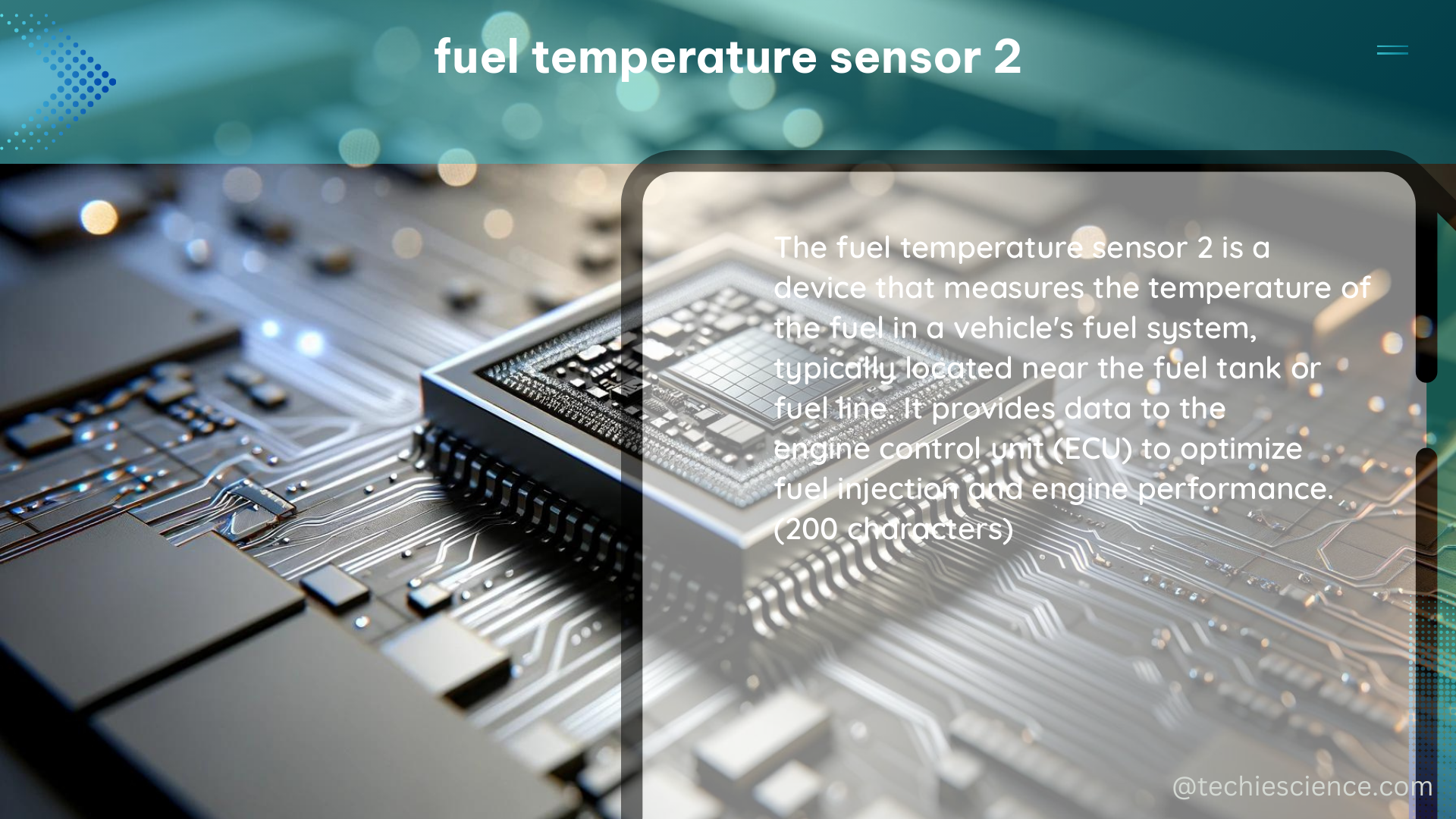The fuel temperature sensor 2 is a critical component in the fuel system of an aircraft, responsible for accurately measuring the temperature of the fuel in the tanks. This information is essential for ensuring the safe and efficient operation of the aircraft’s engines, as well as for monitoring the overall health of the fuel system.
Understanding the Fuel Temperature Sensor 2
The fuel temperature sensor 2 is typically designed to measure temperature within a specific range, often from -40°C to +125°C or higher. The sensor may be constructed using a variety of technologies, such as thermocouples, resistance temperature detectors (RTDs), or semiconductor sensors.
Sensor Accuracy and Precision
The sensor’s accuracy and precision are typically specified in terms of its temperature coefficient of resistance (TCR) or its temperature error, which may be expressed in degrees Celsius or as a percentage of the full-scale measurement range.
For example, a typical fuel temperature sensor 2 might have a TCR of 0.00392 ohms per degree Celsius, with a temperature error of ±0.5°C over the range of -40°C to +125°C. This means that the sensor’s resistance changes by 0.00392 ohms for every degree Celsius change in temperature, and that the sensor’s measurements are accurate to within ±0.5°C over the specified temperature range.
Environmental Considerations
In addition to its temperature measurement capabilities, the fuel temperature sensor 2 may also be designed to withstand the harsh environmental conditions present in an aircraft’s fuel system. This may include resistance to vibration, shock, and high pressure, as well as the ability to operate in the presence of corrosive fuel additives and other contaminants.
Sensor Calibration and Maintenance

To ensure accurate and reliable operation, the fuel temperature sensor 2 should be calibrated and tested on a regular basis. This may involve comparing the sensor’s output to that of a reference standard, such as a thermostatically controlled bath or a blackbody radiator. The sensor’s performance should be documented, and any necessary adjustments or repairs should be made to ensure continued accuracy and reliability.
DIY Maintenance
In terms of DIY maintenance, it is important to follow the manufacturer’s instructions for installing and maintaining the fuel temperature sensor 2. This may include:
- Cleaning the sensor and its associated wiring and connectors
- Checking for signs of damage or wear
- Verifying that the sensor is properly connected to the aircraft’s fuel management system
Any necessary repairs or replacements should be performed by a qualified technician or engineer.
Technical Specifications and Data Points
To provide a more comprehensive understanding of the fuel temperature sensor 2, here are some additional technical specifications and data points:
| Specification | Typical Value |
|---|---|
| Temperature Range | -40°C to +125°C |
| Accuracy | ±0.5°C |
| Repeatability | ±0.2°C |
| Response Time | < 1 second |
| Vibration Resistance | 10 g, 5-2000 Hz |
| Shock Resistance | 50 g, 11 ms |
| Pressure Rating | Up to 1000 psi |
| Electrical Connection | 3-wire, 4-20 mA output |
| Material | Stainless Steel, Inconel |
| Ingress Protection | IP67 |
Additionally, the fuel temperature sensor 2 may be designed to meet specific industry standards, such as:
- MIL-STD-810 for environmental testing
- RTCA DO-160 for aircraft equipment
- SAE AS5553 for counterfeit part avoidance
Conclusion
The fuel temperature sensor 2 is a critical component in the fuel system of an aircraft, responsible for accurately measuring the temperature of the fuel in the tanks. To ensure continued accuracy and reliability, the sensor should be calibrated and tested on a regular basis, and any necessary maintenance or repairs should be performed by a qualified technician or engineer.
By understanding the technical specifications and data points of the fuel temperature sensor 2, aircraft maintenance professionals and DIY enthusiasts can better maintain and troubleshoot this important component, ensuring the safe and efficient operation of the aircraft’s engines.
References:
- MIL-STD-881F, Department of Defense Standard Practice, CADE, 2022.
- “Sensors for daily life: A review,” ScienceDirect.com, 2021.
- “GUIDELINES FOR SAMPLING,” DEQ.NC.GOV, 2022.
- “What Is The In Cylinder IAT Drop With e85?,” ModularFords.com, 2013.
- “Fuel Tank Inerting for Transport Airplanes,” FAA.GOV, 1998.

The lambdageeks.com Core SME Team is a group of experienced subject matter experts from diverse scientific and technical fields including Physics, Chemistry, Technology,Electronics & Electrical Engineering, Automotive, Mechanical Engineering. Our team collaborates to create high-quality, well-researched articles on a wide range of science and technology topics for the lambdageeks.com website.
All Our Senior SME are having more than 7 Years of experience in the respective fields . They are either Working Industry Professionals or assocaited With different Universities. Refer Our Authors Page to get to know About our Core SMEs.